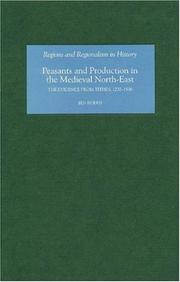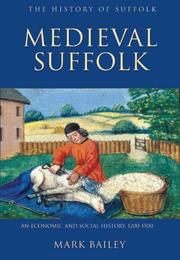| Listing 1 - 2 of 2 |
Sort by
|

ISBN: 1282185748 9786612185748 1846155797 1843832879 Year: 2007 Publisher: Woodbridge : Boydell Press,
Abstract | Keywords | Export | Availability | Bookmark
 Loading...
Loading...Choose an application
- Reference Manager
- EndNote
- RefWorks (Direct export to RefWorks)
Evidence from unused sources sheds much light on the peasant economy of the later middle ages. The peasant economy in north-east England, and indeed throughout the country as a whole, underwent many changes during the later Middle Ages, but owing to the lack of evidence it has been difficult to come to definite conclusions.This pioneering survey uses previously unexploited sources, principally from tithe data, to offer new interpretations of the patterns for change and the scope for adaptability. The author argues that the peasant economy in this region of England was profoundly affected by war in the early fourteenth century and then disease with the arrival of the Black Death in 1349, calling into question the orthodox theories of overpopulation in explaining the "crisis"of the late Middle Ages: even at its medieval peak, the population of northeast England was sparse by comparison with areas further south. Nor did the availability of land and improved living standards lead to demographic recovery in the fifteenth and early sixteenth centuries. He also shows that despite their vulnerability to crises, peasant cultivators were highly responsive to change. Far from being primitive subsistence farmers oblivious to the marketand its signals, medieval peasants in the Durham region were subtle and successful decision-makers regarding the production and marketing of their output. BEN DODDS is Lecturer in History at the University of Tallahassee.
Peasants --- History --- England, North East --- Great Britain --- Economic conditions. --- Peasantry --- Agricultural laborers --- Rural population --- Marks (Medieval land tenure) --- Villeinage --- England, Northeast --- North East England --- Northeast England --- Black Death. --- Decision-makers. --- Land. --- Living standards. --- Market. --- Marketing. --- Medieval North-East England. --- Overpopulation. --- Peasant economy. --- Production. --- War.

ISBN: 1282185667 9786612185663 1846155711 1843833158 Year: 2007 Publisher: Woodbridge, UK ; New York : Boydell Press,
Abstract | Keywords | Export | Availability | Bookmark
 Loading...
Loading...Choose an application
- Reference Manager
- EndNote
- RefWorks (Direct export to RefWorks)
The first volume in what will become the definitive history of Suffolk looks at how the county survived the three most tumultuous events of the period, the Great Famine, the Black Death and the Peasants' Revolt, to emerge as one of the richest English regions. The late middle ages were without doubt the most interesting period in Suffolk's history. By the end of the eleventh century Suffolk was wealthy, densely populated, highly commercialised and urbanised; in the fourteenth century its people faced three of the most tumultuous events of the last millennium, the Great Famine (1315-22), the Black Death (1349) and the Peasants' Revolt (1381). Their response was flexible and innovative, because by 1500 Suffolk was one of the richest and most industrialised regions of England, with a strong economy based on cloth manufacture, fishing, dairying and tanning.
Suffolk (England) --- Great Britain --- History. --- Economic conditions. --- History --- Social conditions. --- County of Suffolk (England) --- Suffolk --- HISTORY / Medieval. --- Black Death. --- Cloth Manufacture. --- Dairying. --- Economic History. --- Economy. --- English Regions. --- Fishing. --- Great Famine. --- Industrialized Region. --- Late Medieval. --- Medieval Suffolk. --- Peasants' Revolt. --- Social History. --- Society. --- Tanning.
| Listing 1 - 2 of 2 |
Sort by
|

 Search
Search Feedback
Feedback About UniCat
About UniCat  Help
Help News
News